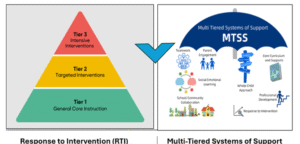Response To Intervention (RTI) & Multi Tiered Systems of Support (MTSS)

Response To Intervention (RTI) & Multi-Tiered Systems of Support (MTSS) are both evidence-based approaches to intervention that use academic assessment and screening data to inform instruction and provide differentiated support or intervention for students. However, there are some distinct differences between them.
Response to Intervention (RTI)
This tiered intervention model, often referred to as Response to Intervention (RTI), consists of three levels or tiers of support designed to meet the varying needs of students. It aims to identify and support students with learning difficulties, and deficits, as early as possible and ensure that they receive the support required to help them succeed academically. There are four main components of RTI:
- Multi-tiered system
- Universal Screening to identify student needs
- Frequent progress monitoring of student performance
- Data driven decision making discussions to guide the selection of evidence-based interventions.
3 Tiers of Support
Tier 1
High quality whole class instruction for all students using evidenced based teaching methods aligned with current science and research.
Tier 2
Targeted small group interventions for students who require additional support beyond Tier 1. Aligned with current research and informed through individual student evidence and data i.e. Universal Screeners, Formative Assessments, Diagnostic Screeners etc.
Tier 3
Intensive interventions for students who do not respond to Tiers 1 & 2 interventions. Frequently 1 on 1 instruction, sometimes small groups.
View Decodable Readers Australia’s information webinar on – RTI Response to Intervention (2022)
Multi-tiered Systems of Support (MTSS)
MTSS is a comprehensive framework that has a much broader or holistic scope. MTSS addresses academic as well as the social and emotional areas that impact on a student’s success at school. For example, MTSS may include the 3 tiers of the RTI model but also include behavioural intervention plans, provide access to professional learning for teachers, and support the development of a network or team of people to support the student and meet their specific requirements.
MTSS can be thought of as an umbrella of support that covers many different approaches and interventions, including:
- Curriculum design
- Positive behaviour intervention and supports
- Teacher learning and collaboration
- Collaboration between school, support agencies and family in problem-solving.
Listen to Dr Stephanie Stollar from The Reading League, talk about Multi-Tiered Systems of Support (MTSS)
https://youtu.be/YykMPlgnePU?si=c2DU8pFDUm5PHCYX
For further information about MTSS I have attached several resources for your reference.
Multi-tiered system of supports: User guide | Australian Education Research Organisation
Nearly 1 in 5 Australian students start secondary school at or below minimum standards for literacy or numeracy. This puts them at least 3 years behind their peers. When students struggle with literacy and numeracy, particularly at a foundational level, they can become disengaged and fall further behind their peers, making it difficult for them to catch up.
The Australian Education Research Organisation (AERO) recommends the use of a multi-tiered system of supports (MTSS) to better assist Years 7 to 9 students struggling with foundational literacy and numeracy skills.
AERO has developed a suite of resources for secondary school leaders and teachers looking to use MTSS to better support Years 7 to 9 students struggling with foundational literacy and numeracy skills. The resources are designed to equip school leaders to effectively deliver an impactful and sustainable MTSS framework.
This user guide:
-
- explains AERO’s MTSS resources
- recommends the most relevant resources for teachers and leaders depending on their responsibilities
provides suggestions for their use. (Excerpt from AERO, 2025)
Introduction to a multi-tiered system of supports | Australian Education Research Organisation
Using assessments to support an MTSS framework | Australian Education Research Organisation
Support tiered interventions | Australian Education Research Organisation
Tiered interventions | Australian Education Research Organisation
What to Do If You Suspect a Secondary Student Has a Learning Disability
Articles
Tiered literacy and numeracy interventions | Australian Education Research Organisation
